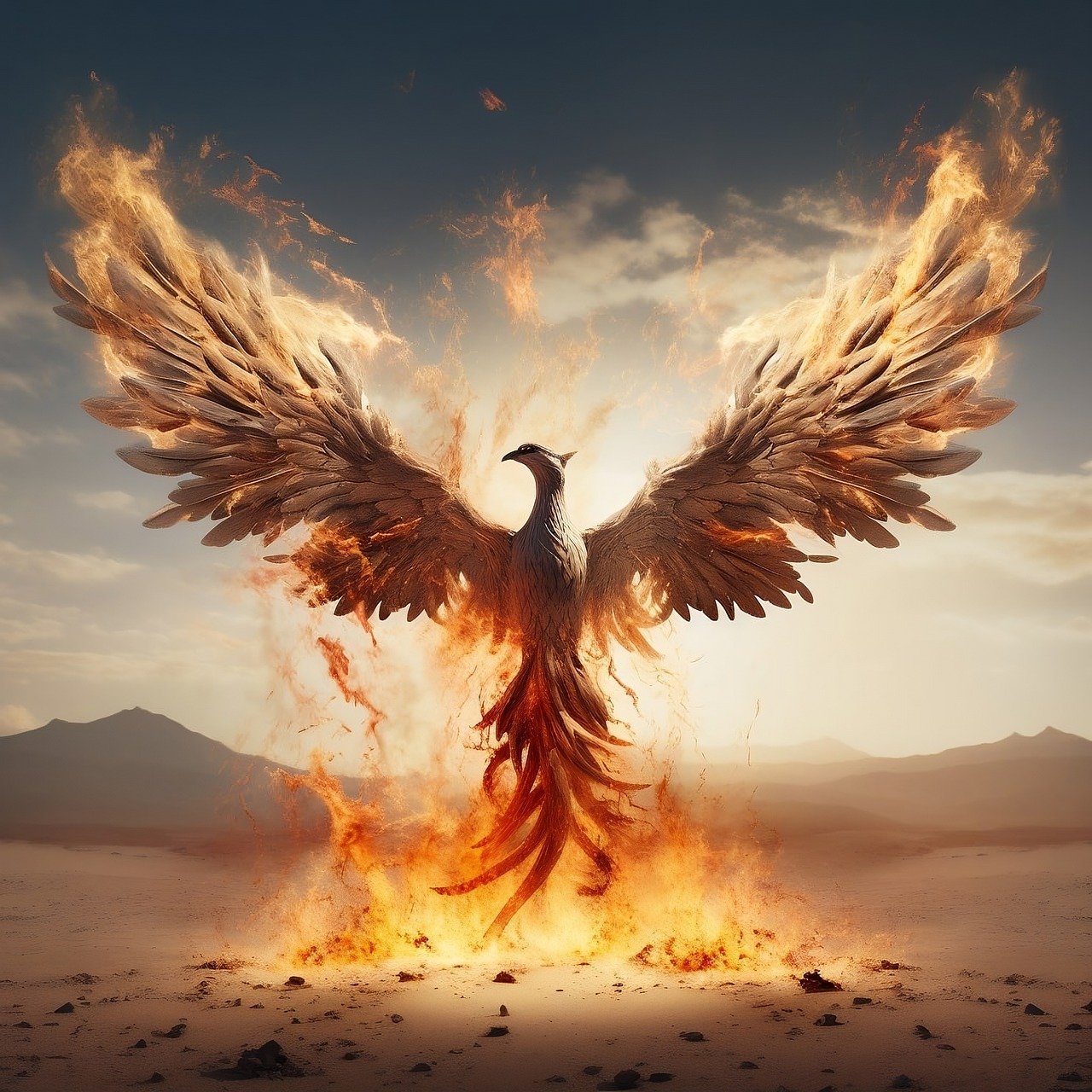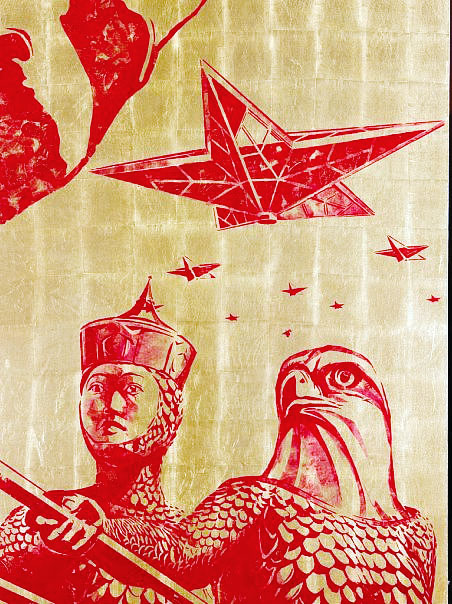Myth for us – except in exceptional cases of extreme degradation and the secularisation of tradition and culture – is not the fiction of primitives, superstition, or misunderstanding. Instead, myth is a concise expression of the highest sacred truths and principles, which are “translated” into a specific language for worldly life to the extent that such is practically possible. Myth is sacred truth expressed in popular language. Wherever the preconditions for a myth’s understanding disappear, the mythical content must be discarded for another to take its place.
The contradictory processes of de-mythologisation and re-mythologisation were not unknown to ancient civilisations, in which old myths were sometimes destroyed (de-mythologisation) and replaced with new myths (re-mythologisation). In other words, the processes of de-mythologisation and re-mythologisation are mutually conditioned and dependent processes. They do not call into question the very foundation of traditional mythical associations; rather, they keep them eternally current and alive.
Dangerous Intuitions
In Greece, the process of de-mythologisation reached its complete and radical peak after Xenophanes (565–470). This was not followed by any process of re-mythologisation, it was the consequence of a total de-sacralisation and profanation of culture, whose result was the extinguishing of the mythical and the awakening of historical consciousness, in which man ceases to see himself as mythical and instead begins to understand himself as a historical being. This is a phenomenon that has analogies in two moments in history: the first was the process of de-mythologisation brought by early Christianity.
For the first Christian theologians, myth was the opposite of the Gospel, and Jesus was a historical figure whose historicity the Church Fathers proved and defended to the unbelieving. This was contrasted by the process of re-mythologisation of the Middle Ages which saw a whole series of revitalisations of ancient mythical content, often conflicting and irreconcilable, ranging from the Grail myths to the myth of Frederick II, eschatological myths in the era of the Crusades, and various millenarian myths. Such was, without a doubt, the re-actualisation of mythical content and their “dangerous intuitions” which transcend their causes and serve as evidence of the very presence of mythical forces within the historical world, which no process of de-mythologisation is capable of destroying or extinguishing.
The Consumer Mythology: The Midnight of History
Another example of the radical process of de-mythologisation was that brought by the Enlightenment era to its peak in the “technological universe.” This is the direct expression of the degradation and decline of modern man, who is no longer a mythical or historical being but merely a “consumer” within the “consumerist and technocratic civilisation,” or simply an “appendix” to the technological universe. The heroic impulse of man as a mythical being, or even a historical being, was extinguished. The destructive forces of de-mythologisation constantly purged and expunged mythical components from the domain of consumerist civilisation and human memory in general, exterminating the “dangerous intuitions” harboured within them. Within the technological universe, which is only the final stage of the fall of (modern) man, the human horizon is finally closing because here man has only one power and only one freedom: the power to spend and the freedom to buy and sell. This freedom and this power testify to the death of man (as known by myth and history) because within the universe of technology and the consumer civilisation anything that transcends this “animal of consumption” cannot exist. “The death of art” spoken of by the historical avant-garde was simply a consequence of the death of man, first as a mythical being, then as a historical being.
Of course, the process of de-mythologisation can never be completed for the simple reason that destruction does not touch the mythical forces themselves. They continue to appear and return through history, whether under the guise of the “historical” or as something opposed to history. This is also true for the one-dimensional universe of the technocratic utopia. As a result, in the consumer civilisation, real mythical components are replaced by mythical simulacra, by self-sown sub-cultural ideologies and the “myths” of the consumer mythology whose heroes are comic book figures such as Superman. But the exhaustion of the long and destructive processes of de-mythologisation does not mean a return to mythical time. The German author Ernst Jünger wrote in his At the Wall of Time:
We are standing at the midnight of history, the clock has struck twelve and we look ahead into the darkness, where we see the contours of future things. This view is followed by fear and heavy premonition. Things we see or think that we can see still do not have a name, they are nameless. If we address them, we do not intuit them accurately and they escape the noose of our control. When we say peace, it could be war. Plans of happiness turn into murderous ones, often overnight.
In short: “Rough incursions, which in many places convert historical landscapes into elementary ones, hide subtle changes of a more aggressive kind.”
At the Dawn of History
Ernst Jünger’s At the Wall of Time conveys much about the transition of myth into history, about the moment in which mythical consciousness is replaced by the historical. History, of course, has not existed as long as man has historical consciousness and rejects as non-historical the vast spaces and epochs of “pre-history” – whole peoples, civilisations, and countries – because “some person or some event must have very specific characteristics that would make them historical.” The key to this transition, according to Jünger, is provided in the work of Herodotus through which man today “passes as through a land illuminated by the rays of dawn”:
Before him (Herodotus) there was something else: mythical night. That night, however, was not darkness. It was more of a dream, and it knew of a different connection between people and events than that of historical consciousness and its selective forces. This brings rays of dawn into Herodotus’ work. He stands on top of the mountain that separates day from night: not only are there two epochs, but also two types of epochs, two types of light.
In other words, what we call history is the moment of transition from one mode of existence to something quite different. This is the time of the shift of two cycles which we cannot identify with a change of historical epochs – the matter in question is a profound change in the very existence of man. The sacred in the manner of previous epochs retreats, ancient cults disappear, and in their place come religions which soon afterwards become historical or anti-historical, even when they trigger events and historical plots. The Crusades called by the Western Church deepened divisions and schisms, and eventually gave birth to the Reformation, which began with religious enthusiasm and the desire to return to “biblical beginnings,” only to end with a historical movement which opened the way for the unhampered development of industry and technology unconstrained by the norms of (Christian) tradition and free from human hopes and desires.
Artwork by Alexey Belyaev-Guintovt
The Grimace of Horror
The historical world, the outlines of which we can find in Homer and which were shaped by Thucydides, reached its zenith somewhere at the end of the 19th and beginning of the 20th century with unclear boundaries in time and space. But upon clear consciousness of its laws and regulations, it started to collapse and the vast edifice of history became unstable, signifying penetration by hitherto unknown foreign forces. These forces have a Titanic elementary character, first seen in technological disasters which claimed hundreds of thousands of victims and then in the cataclysmic events of the 20th century, in the world wars and revolutions in which millions were killed and crippled. The release of nuclear energy, radiation, and the environmental destruction that enormous areas were exposed to, the daily toll in blood, whether it was sacrificed to “progress” in peacetime conditions or as a direct consequence of military intervention and conflicts, represented something that emerged out of the framework established by the historical world.
Of course, history did not end there, as was expected by Marx or Fukuyama. Rather, what really became apparent is the acceleration of historical time, which condenses events and shortens the distances between key turning points of history. The point, however, is that those forces which we have called historical do not operate alone, and man’s role in these events is fundamentally changing: he is no longer able to act on an equal footing with the gods, to follow them, oppose them, or even subdue them as is represented in myth. As was still the case in the mature historical era, he is no longer an active participant in history guided by passions or his own will. Instead, he now becomes the plaything of something unknown, involved in events that surpass him, against his will and outside of his ideas.
The expression of cheerful self-confidence is gradually replaced by a grimace of horror. Man, who until yesterday considered himself a sovereign and master, realises his weakness. The means on which he relied to turn against his creator at the decisive moment prove powerless. Technological systems and social arrangements have their reverse side, their automatic features that do not restrain but encourage destruction, putting man in the position of a wizard’s apprentice who frees forces that he is too immature to handle. Corruption, crime, violence, and terror are consequences rather than causes, and political responses, regardless of colour and sign, do not offer solutions but increase disarray. If the hour of panic had not descended, man would have at least gained awareness of his own downfall.
All of this was unthinkable in the mature historical age because man then was still ruled by himself, and thus history as well. History, therefore, could have no sense of direction other than the one given by man himself, his own deeds and thoughts. Each concept of the “meaning of history” was a concept of the emergence of man, whereas in the classical historical age man did not emerge but simply was. The question of the “meaning of history” was a meaningless question, and it is not found in the works of classical writers from Herodotus and beyond. The question of the “meaning of history,” which is always found outside of man, becomes possible only when the focus of history shifts beyond man himself, whether into the sphere of social or technological relations.
Modern man discovers his weakness too late. His collapse is not to be blamed on myth or history but on none other than the weakness and cowardice of modern man. The world of “civilised values,” and the historical world in general which he created, proves to be much weaker than we have been accustomed to believe – weaker structurally, spiritually, and ethically. At the first sign of alarm, it begins to collapse, revealing what is, in fact, modern man’s inner readiness for capitulation.
This is the “midnight of history” that will soon be replaced by something different; this moment is marked by the spread of Titanic forces demanding sacrifices of blood.
Toward Post-History: The Awakening of Myth
History, let us repeat, has not lasted as long as has man on Earth. But consciousness of this only occurs late within history, perhaps only at its end, when the boundaries of time and space change – on the one hand with the discovery of the distant past of man and lost civilisations, then the past of the planet and the cosmos, and on the other with the discovery of space, of the ocean depths, and the interior of the Earth through archaeological and geological layers in a virtually Vernean way. New perspectives cause dizziness. Pre-history and post-history gain in importance only when history becomes a crumbling edifice. Yet, man’s turn from history towards something that he is not yet able to define or see clearly now resembles escape.
In one way or another, the technological universe and the consumer civilisation will come to an end, in the same way that the classical historical epoch ended with technocracy and totalitarian order in its complete form, which arose not out of courage or strength but out of cowardice, weakness, and fear. It is impossible to say how long this will take. It is also irrelevant whether this will happen due to internal attrition, overreach, disaster, or a combination of all these factors together. But in each of these cases, collapse is the consequence of man’s inability to dwell within the historical world and to rule it as a sovereign-supreme being.
However, the return of myth is not possible in the sense of a return to the state of “pre-history.” Mythological forces remain present, just as they have been during the entire historical period, but they cannot establish the previous state for lack of the necessary preconditions. First and foremost, the “substrate,” the fertile ground, is missing, as modern man is too weak in the spiritual, psychological, and even “physiological” senses.
Together with history, culture and its current meaning gradually disappear as well, remaining a mere instrument of social engineering. In the technocratic utopia, mass culture (as opposed to the culture of the historical period) is just one of the ways for the utopian fantasies and desires of the masses to be channelled. The elite culture, meanwhile, which constantly drifts between conformism and negation, between scepticism and denial, between scepticism and irony and back again to conformism, remains essentially a tool of de-mythologisation and the suppression of the dangerous intuitions contained in myth, thus enabling more or less painless integration into the technological universe under the illusion of free will. The appearance and awakening of dangerous intuitions and dormant archetypes on the margins of the technocratic social mechanism creates a situation of conflict and leads to glitches in its functioning.
In the domains beyond the technocratic utopia, culture will need to take a more traditional role than the one it assumes under consumer civilisation. The disintegration of the historical world in its final stage, which we are witnessing today, allows us to see something out of it.
For much of the historical period, culture was the privileged domain of sacred and mythical forces. This is one of the ways in which mythical forces can penetrate the world again – historically, realising themselves in history, unlike in the technological universe where they usually manifest themselves through the uncontrolled elements of folkloric subcultures and are often distorted to the point of being unrecognisable simulacra of the mythical, not veritable expressions. Such testify more to the eternal and unquenched need of man for mythical content than they represent a sign of the real presence of the mythical.
In the post-technocratic era, culture will be very closely tied to re-mythologisation under the sign of re-recognising and re-awakening true mythical content, the revitalisation and innovation of ancient and traditional forms instead of, as before, their exorcism. The meaning and purpose of de-mythologisation, on the other hand, must be limited to its capacity in traditional societies – to the purification of degenerate “folkloric” mythical forms so that in their place may come forms which veritably represent tradition.
Boris Nad - https://www.newdawnmagazine.com/articles/the-return-of-myth
The above text is based on passages from Boris Nad’s first volume of selected works in English, The Reawakening of Myth (PRAV Publishing, 2020), available from PravPublishing.com.
© Copyright New Dawn Magazine, www.newdawnmagazine.com. Permission granted to freely distribute this article for non-commercial purposes if unedited and copied in full, including this notice.
© Copyright New Dawn Magazine, www.newdawnmagazine.com. Permission to re-send, post and place on web sites for non-commercial purposes, and if shown only in its entirety with no changes or additions. This notice must accompany all re-posting.


